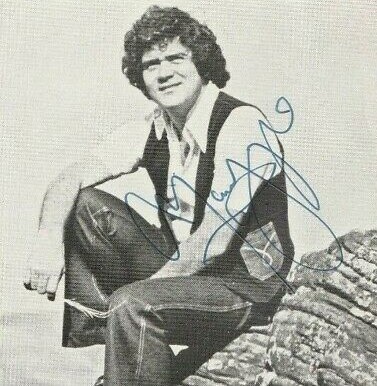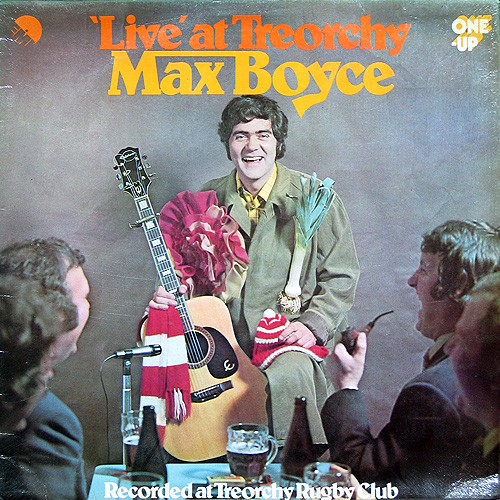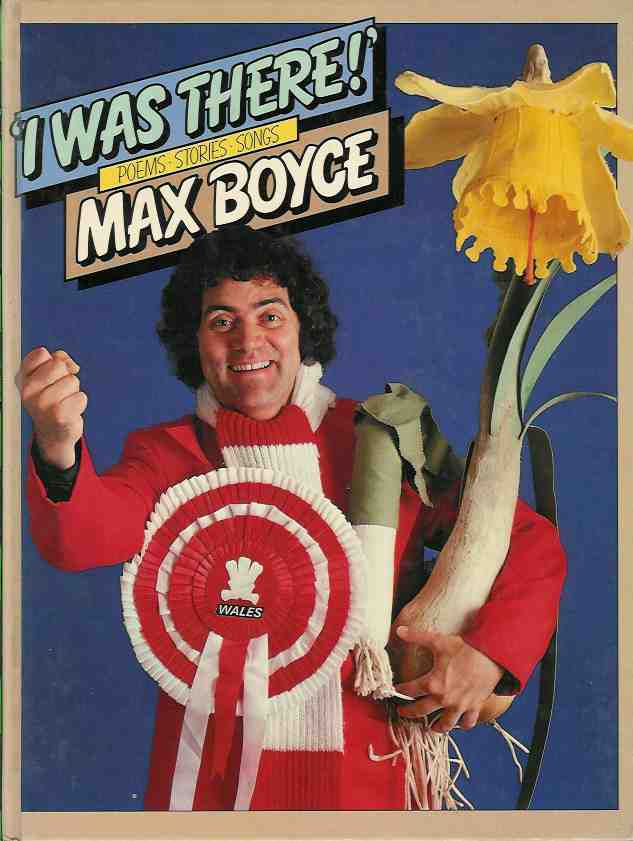Max Boyce

MAX BOYCE, MBE, is a much-loved comedian, singer and entertainer, who rose to fame during the mid-1970s with an act that combined musical comedy with his passion for rugby union and his origins in the mining communities of south Wales. He has sold more than two million albums in a career spanning four decades.
Born in Glynneath on September 27, 1943, Boyce, whose songs and stories have become part of folk culture, has taken his unique brand of Welsh humour to many far-flung places around the world, but always finds his way back to his beloved home town, resolutely remaining true to his Welsh roots.
While superstars such as Tom Jones and Shirley Bassey chose to spend their days living abroad, Boyce remained in his valleys birthplace of Glynneath, among the people and places that influenced his music so strongly.
He continues to play an active role within his community, having been in recent years the president of Glynneath Rugby Football Club and the president of Glynneath Golf Club, where the ‘Max Boyce Classic’ is held every two or three years.
His family were originally from Ynyshir in the Rhondda Valley. Around the time of Boyce’s birth, his father died in an explosion in the coal pit where he was working. At the age of 15, Boyce left school, went to live with his grandfather, and followed his father’s footsteps by working in a colliery for around eight years.
In his early 20s, he managed to find alternative work in the Metal Box factory, Melin, Neath, as an electrician’s apprentice, yet his earlier mining experiences were to colour his music considerably in later years in works such as the heartfelt Duw! It’s Hard and Rhondda Grey.
Boyce first learned to play the guitar as a young man, but he showed no particular flair for the instrument, nor any actual desire to become a performer. In his own words: “[I had] no desire at all to be anything. I had a love of poetry, and eventually started writing songs without any ambition to build a career. It just happened. I started writing songs about local things and it evolved.”
The stage, it seems, gave him the license to rid himself of any inherent shyness or insecurity. He became a wonderfully unique performer and his concerts were, as one London critic remarked: “Not so much an evening of music, more of an evening out with an eccentric Welsh friend”.

Boyce once wrote that his influences had been Dylan Thomas and Al Read. His real influence, however, is recognised as being the community in which he grew up. The mining valleys of south Wales; tight-knit communities with their inherent warmth and humour, sadness and passion. It was here “where they emptied the hills to warm the world” he would find his seams of humour and his veins of inspired fantasy and storytelling.
“It was always a love-hate relationship,” he said. “It had a huge effect on communities, but the mines were a terrible place to work. Certainly in some places it was worse than others. However bad it could be, it was a way of life, it was the way it was then. Nobody wanted to work in those conditions, but there was no other work to be had.”
His coal-mining and industrial ballads serve as a reminder of a particular time and place, and are deserving of permanence. His miners strike songs like Did You Understand? and A Winter Too Late bear testimony to his experience of working underground for almost a decade after leaving school.
Indeed, many would argue that Max’s serious songs are amongst his finest work. This has been recognised by the National Folk Museum of Wales who have collected some of his songs, recognising them as ‘songs of the people’ – the essence of the contemporary folk song. They are songs of the working man much in the same vein as Ewan McColl’s Shoals of Herring and Pete Seager’s Songs of the Dust Bowl.

Despite his early lack of musical ambition, in time he became competent enough to perform at local eisteddfodau, one of the earliest known recordings of his work being O Na Le, a folk tune in Welsh which he played at the Dyffryn Lliw Eisteddfod in 1967. Boyce was later inducted into the Gorsedd of Bards at the 1971 National Eisteddfod of Wales.
In the early 1970s, Boyce undertook a mining engineering degree at the Glamorgan School of Mines in Trefforest (now the University of South Wales), during which he began to pen tunes about life in the mining communities of south Wales.
He started out performing in local sports clubs and folk clubs around 1970, where his original set began to take on a humorous element, interspersed by anecdotes of Welsh community life and of the national sport, rugby union.
The first recording of Boyce’s songs was made at the Valley Folk Club in Pontardawe in 1971 by Cambrian Records, which subsequently released an LP called Max Boyce in Session. This album included several tracks that were to later become his signature tunes, including Hymns and Arias, Duw! It’s Hard and Slow – Men at Work.
The record sleeve of this album foretold of the impact Max Boyce would have on Welsh folk culture. It included the accurate prediction: ‘It may well be that future years will find Hymns and Arias rolling a thunderous chorus across the terraced rugby grounds’. How right they were!
In the same year, he also recorded Caneuon Amrywiol (Miscellaneous Songs), a collection of Welsh folk songs under the same label. Nevertheless, Boyce remained virtually unknown beyond the music clubs of the south Wales valleys for the time being, where he continued to perform.
This all changed towards the end of 1973. Boyce had competed, unsuccessfully, on the television talent show Opportunity Knocks, shortly before record label EMI heard his first album, came to see him in concert, and offered him a recording contract.
So it was that Max Boyce crossed the Rhigos Mountains from his home in Glynneath on November 23, 1973, to record an album Live at Treorchy… little did he know it would change his life.
The musicians for that evening were hastily gathered together that afternoon. With virtually no rehearsal, the songs and stories were recorded. The audience, apart from a few close friends were given the tickets after failing to sell them for 50 pence each.

Armed with songs such as The Outside-Half Factory, Rhondda Grey and The Ballad of Morgan The Moon he could hardly fail. The reaction of the Treorchy Rugby Club audience that night was integral to the evening’s success. No-one who was there would ever forget the heady mix of laughter and song.
“I was doing a degree as a mining engineer, and the music evolved over a long period of time,” recalled Boyce. “First there was no comedy at all, just straight folk songs. The comedy came because I used to sing in folk clubs. Playing in folk clubs gave you the chance to talk and for people to listen. On other circuits you had to do whatever the ‘in’ song was. I had the chance to experiment. This was around 1972, and I started introducing my set with little anecdotes. Gradually the anecdotes took over.”
The Live At Treorchy album went gold, going on to sell well over half a million copies worldwide, and EMI released a follow-up in late 1975, We All Had Doctors’ Papers, recorded this time at Pontarddulais Rugby Club. Unexpectedly, it reached number one in the album charts, and earned Max a place in the Guinness Book of Records as the only comedy album to achieve that coveted position. He received further gold discs for The Incredible Plan (1976) and I Know ‘Cos I Was There (1978).
His spoken and sung poetry was collected in print in Max Boyce: His Songs and Poems in 1976, with an introduction by rugby legend Barry John. The comic illustrations that accompany the poems were drawn by his friend Gren Jones, cartoonist for the South Wales Echo (who had also illustrated the cover of We All Had Doctors’ Papers). This publication was followed up with a similar collection, I Was There!

This early pinnacle in Boyce’s career happily coincided with the dominance of the Wales rugby team in the Five Nations Championship during the 1970s. His songs and poems were real-time reflections on this unfolding history, often invoking the names of Welsh rugby greats such as John, Gareth Edwards and Dai Morris.
Hymns and Arias soon became popular with rugby crowds, a fact which has played a significant part in his ongoing popularity. When Swansea City were promoted to the English Premier League in 2011, Boyce was asked to perform for their first game and produced a special version of Hymns and Arias for the occasion.
His rise to fame was confirmed by an appearance on the long-running biographical series This Is Your Life on February 22, 1978. He had gone along as usual to watch his local team Glynneath RFC play their traditional eve of the Wales v Scotland rugby international fixture against old friends from Hawick Trades RFC from the borders of Scotland.
However, at the end of the game, when Max thought he was about to be interviewed on HTV on the affinity between the two clubs and countries, up stepped Eamonn Andrews with the famous red book and those immortal words: ‘This is Your Life’.
A hugely successful BBC TV series followed and Boyce continued to enjoy a varied career on stage and screen throughout the ’80s and ’90s, including spells in pantomime, and three ‘adventure specials’ which saw him throwing himself into the roles of American Football player, rodeo cowboy and elephant polo player.

His made-for-television adventures in America and Nepal, as well as many other anecdotes of his worldwide touring throughout the late 1970s and early 1980s, became the focus of an autobiography, Max Boyce in the Mad Pursuit of Applause, which was first published in 1987.
Max has never been afraid to take his songs and stories to distant lands, always supplying him with yet more wonderful anecdotal stories. So when he was offered a 10-concert tour of the Falkland and Ascension Islands, he readily accepted.
With a full entourage of technicians and musicians, dancers and support acts, they left RAF Brize Norton for Las Malvinas. He performed in the great hangers of RAF Mt Pleasant and the Radar Stations on the snowbound summits of Mt Alice, Mt Kent and the Byron Heights.
The welcome was overwhelming and genuine and an experience Max would never forget, visiting places like Goose Green and Bluff Cove where so many of his compatriots fell during the Falklands War. His ability to work in almost impossible conditions, such as was found in the steel containers that served as ‘Concert Halls’ in that bleak land, warmed everyone to him.
In 1995 Max undertook his first tour of South Africa to coincide with the World Cup. He played to packed-out audiences who fell in love with his unique brand of humour and storytelling.
An Evening With Max Boyce introduced him to a younger television audience, with ratings that broke BBC Wales viewing records.
His enduring place in the hearts of Welsh people was recognised by his invitation to play at the opening of the Welsh Assembly and at the 1999 Rugby World Cup, where he joined the Millennium Stadium crowd in singing his legendary Hymns and Arias.
Not long after, Boyce was included on the 2000 New Year Honours list, and received an MBE from Prince Charles in a ceremony at Cardiff Castle on March 15 that year. According to Boyce, “He (the Prince) said he was surprised it took them so long” to accord him this honour.
He was also made an Honorary Fellow of the Welsh College of Music and Drama and a recipient of the first ever Chancellors medal from Glamorgan University, which he had attended as a mining apprentice.
Boyce’s greatest musical success in recent years was his 2003 tour of Australia, coinciding with the Rugby World Cup which was being hosted there at the time. He held concerts in Adelaide and Melbourne, but the highlight was his sold-out performance at the Sydney Opera House, which was later released on DVD as Max Boyce: Down Under.
A special guest that night was a young unknown, Katherine Jenkins, who would go on to achieve worldwide fame, performing hymns and arias of her own as an operatic mezzo-soprano.
Such was the popularity of the programme it was nominated by the BBC for a BAFTA award. Another sell-out British concert tour followed, including seven full-house concerts at the Millennium Centre in Cardiff.

On May 29, 2006, Max Boyce headlined at a concert in Pontypridd to celebrate the 150th anniversary of the Welsh national anthem, Hen Wlad fy Nhadau.
Boyce returned to Treorchy in early 2011 to perform a show at the Parc and Dare Theatre, shown on St David’s Day on BBC1 Wales. He was joined on stage by guests including Welsh actor Boyd Clack, and the audience featured such Welsh icons as rugby scrum-half legend Gareth Edwards.
His 70th birthday was celebrated with an hour-long programme shown on BBC One Wales on September 25, 2013, recorded in front of a live celebrity audience.
In 2014,Boyce was diagnosed with heart problems and underwent a quadruple heart bypass. He was even able to see the funny side of that life-threatening situation, when he joked that being admitted on Friday 13th proved a bit of a worry: “I told them straight – there’s no way I’m having an operation on that day, so they waited until Saturday the 14th,” said Boyce.
“But that still didn’t stop me getting a South African surgeon to carry out the procedure – and on the day Wales took on the Springboks in Durban too! Honestly, you couldn’t make it up.”
Underlining his folk-hero status, in 2007, Boyce was voted by Red Dragon FM as Wales’s greatest living legend.
Part of his enduring success is that he has never laughed at his own people, but always with them. His humour is never spiteful or hurtful – even when taunting the English!
There are not many international performers, never mind from Wales, who have filled the Royal Albert Hall, Sydney Opera House, the London Palladium and broken box-office records all over Great Britain.

Jack Waterman wrote in The Listener in 1979: “Harry Secombe is one of the most famous of comedians from Wales. His reputation, however, rests with his singing and Neddy Seagoonery. Sir Geraint Evans possessed considerable talent for comedy and made us laugh in the roles of Falstaff and Leporello, but his career depended every move on his voice. Until Max Boyce, I can think of no-one who has become famous outside Wales for his Welshness.”
Discography, Albums
Max Boyce in Session: 1971 · Cambrian Records
Caneuon Amrywiol: 1971 · Cambrian Records
Live at Treorchy: 1974 · EMI (re-released on CD in 1995) (gold)
We All Had Doctors’ Papers: 1975 · EMI (gold)
The Incredible Plan: 1976 · EMI (gold)
The Road and Miles: 1977 · EMI
I Know ‘Cos I Was There: 1978 · EMI (gold)
Not that I am Biased: 1979 · EMI
Me and Billy Williams: 1980 · EMI
Farewell to the North Enclosure: 1980 · EMI
It’s Good to See You: 1981 · EMI
Troubadour: 1987 · EMI
Published works
Max Boyce: His Songs and Poems (1976), ISBN 0-586-04621-6
I Was There! (1979), ISBN 0-297-77609-6
Max Boyce in the Mad Pursuit of Applause (1987), ISBN 1-85145-136-6
RETURN TO WELSH GREATS IN PROFILE
BACK TO HOME PAGE